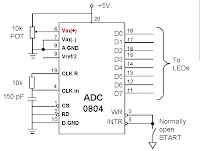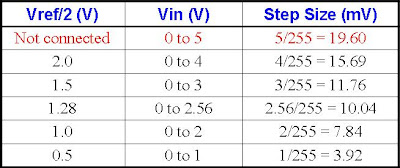This post is the continuetion of last post in which we discussed the Analog interfacing with microcontroller. We learnt that the transducers required --- in middle to have interfacing with microcontrollers. This post is about the ADC interfacing and working.
Thus we can say that we need to have some means to convert the analog signal of transducers into digital signal so that computers can handle it and further processing could be done.
Analog-to-digital converter (ADC) is a device which can convert analogue voltage to digital numbers so that microcontrollers can handle and process the data. This is required to obtain some meaningful results or any useful work with micro controller. ADCs are the most widely used devices for data acquisition and control. Some microcontrollers have built in ADCs but the 8051 micro controller don't have any built in ADC. So we have to use external ADC for said purpose. There some common and important features about ADCs. for example, resolution of adc, response time of adc , mode of workand method of conversion. ADC has n-bit resolution, where n can be 8, 12, 16 or even 24 bits. The higher-resolution ADC provides a smaller step size.Step size is the smallest change that can be recognized by ADC. The heart of any current computational device relies upon digital bits, voltage states which can be at either high or low voltages. One of the simplest constructions, the ADC, converts an analog voltage signal to a digital one. Analog to Digital converters, and their counterparts,Digital to Analog converters are used all the time in electronics. Indeed, they provide the only method by which one may interface a digital system with the real world, which functions in analog.Digital data acquisition and conversion systems are ubiquitous, being found in virtually every modern communication, digital signal processing (DSP), electronic instrument, and micro-controller applications. Regardless of the sophistication of the application, a data acquisition and/or conversion system will consist of some pre-processing elements, a domain conversion device (digital to analog conversion (ADC) or analog to digital conversion (DAC)), controller, and post-processing agent.
8-Bit resolution ADCs:-
An ADC has a resolution of 8 bits, the range is divided into 2^8=256 steps (from 0 – 255). But there are 255 quantization levels.
Where the Vcc is the reference voltage of ADC with n-bit resolution.Below is table in which Resolution versus Step Size for ADC (if Vcc = 5V) is provided.
ADC0804 Chip (Free Running Mode)
There are some control PINs and some input and other are output PINS of ADC0804. The pin configuration of ADC0804 is shown in the figure below.
Important pins are discussed here in some detail.
CS :Active low input used to activate the ADC0804 chip.
RD (data enable) : Active low input used to get converted data out of the ADC0804 chip. When CS = 0, if a high-to-low pulse is applied to the RD pin, the 8-bit digital output shows up at the D0-D7 data pins.
WR (start conversion): Active low input used to inform the ADC0804 to start the conversion process. If CS = 0 when WR makes a low-to-high transition, the ADC0804 starts converting the analog input value of Vin to an 8-bit digital number. When the data conversion is complete, the INTR pin is forced low by the ADC0804.
CLK IN and CLK R : Connect to external capacitor and resistor for self-clocking, f = 1/(1.1RC). The clock affect the conversion time and this time cannot be faster than 110 micros.
INTR (end of conversion) This is an active low output pin. When the conversion is finished, it goes low to signal the CPU that the converted data is ready to be picked up. After INTR goes low, we make CS = 0 and send a high-to-low pulse to the RD pin to get the data out of the ADC0804 chip.
Vin (+) and Vin (-) :These are the differential analog inputs where Vin = Vin (+) - Vin (-). Often the Vin (-) pin is connected to ground and the Vin (+) pin is used as the analog input to be converted to digital.
VCC : This is the +5V power supply. It is also used as a reference voltage when the Vref/2 (pin 9) input is open.
Pin Vref/2 is open, Step size =19.6mV
Vref/2 :- Input voltage pin used for the reference voltage. If this pin is open, the analog input voltage for the the ADC is ranged from 0 to 5 volts.This is optional input pin. It is used only when the input signal range is small. When pin 9 is at 2V, the range is 0-4V, i.e. Twice the voltage at pin 9. Pin 6 (V+), Pin 7(V-): The actual input is the difference in voltages applied to these pins. The analogue input can range from 0 to 5V.
D0 – D7 output PINs of ADC: D0 – D7 are the digital data output pins. These are the tri-state buffered and the converted data is accessed only when CS = 0 and RD is forced low. The output voltage:
Analog Ground and Digital Ground :- Analog ground is connected to the ground of the analog signal while digital ground is connected to the ground of the Vcc pin.
Operation of the ADCThus we can say that we need to have some means to convert the analog signal of transducers into digital signal so that computers can handle it and further processing could be done.
Analog-to-digital converter (ADC) is a device which can convert analogue voltage to digital numbers so that microcontrollers can handle and process the data. This is required to obtain some meaningful results or any useful work with micro controller. ADCs are the most widely used devices for data acquisition and control. Some microcontrollers have built in ADCs but the 8051 micro controller don't have any built in ADC. So we have to use external ADC for said purpose. There some common and important features about ADCs. for example, resolution of adc, response time of adc , mode of workand method of conversion. ADC has n-bit resolution, where n can be 8, 12, 16 or even 24 bits. The higher-resolution ADC provides a smaller step size.Step size is the smallest change that can be recognized by ADC. The heart of any current computational device relies upon digital bits, voltage states which can be at either high or low voltages. One of the simplest constructions, the ADC, converts an analog voltage signal to a digital one. Analog to Digital converters, and their counterparts,Digital to Analog converters are used all the time in electronics. Indeed, they provide the only method by which one may interface a digital system with the real world, which functions in analog.Digital data acquisition and conversion systems are ubiquitous, being found in virtually every modern communication, digital signal processing (DSP), electronic instrument, and micro-controller applications. Regardless of the sophistication of the application, a data acquisition and/or conversion system will consist of some pre-processing elements, a domain conversion device (digital to analog conversion (ADC) or analog to digital conversion (DAC)), controller, and post-processing agent.
8-Bit resolution ADCs:-
An ADC has a resolution of 8 bits, the range is divided into 2^8=256 steps (from 0 – 255). But there are 255 quantization levels.
Where the Vcc is the reference voltage of ADC with n-bit resolution.Below is table in which Resolution versus Step Size for ADC (if Vcc = 5V) is provided.
ADC0804 Chip (Free Running Mode)
There are some control PINs and some input and other are output PINS of ADC0804. The pin configuration of ADC0804 is shown in the figure below.
Important pins are discussed here in some detail.
CS :Active low input used to activate the ADC0804 chip.
RD (data enable) : Active low input used to get converted data out of the ADC0804 chip. When CS = 0, if a high-to-low pulse is applied to the RD pin, the 8-bit digital output shows up at the D0-D7 data pins.
WR (start conversion): Active low input used to inform the ADC0804 to start the conversion process. If CS = 0 when WR makes a low-to-high transition, the ADC0804 starts converting the analog input value of Vin to an 8-bit digital number. When the data conversion is complete, the INTR pin is forced low by the ADC0804.
CLK IN and CLK R : Connect to external capacitor and resistor for self-clocking, f = 1/(1.1RC). The clock affect the conversion time and this time cannot be faster than 110 micros.
INTR (end of conversion) This is an active low output pin. When the conversion is finished, it goes low to signal the CPU that the converted data is ready to be picked up. After INTR goes low, we make CS = 0 and send a high-to-low pulse to the RD pin to get the data out of the ADC0804 chip.
Vin (+) and Vin (-) :These are the differential analog inputs where Vin = Vin (+) - Vin (-). Often the Vin (-) pin is connected to ground and the Vin (+) pin is used as the analog input to be converted to digital.
VCC : This is the +5V power supply. It is also used as a reference voltage when the Vref/2 (pin 9) input is open.
Pin Vref/2 is open, Step size =19.6mV
Vref/2 :- Input voltage pin used for the reference voltage. If this pin is open, the analog input voltage for the the ADC is ranged from 0 to 5 volts.This is optional input pin. It is used only when the input signal range is small. When pin 9 is at 2V, the range is 0-4V, i.e. Twice the voltage at pin 9. Pin 6 (V+), Pin 7(V-): The actual input is the difference in voltages applied to these pins. The analogue input can range from 0 to 5V.
D0 – D7 output PINs of ADC: D0 – D7 are the digital data output pins. These are the tri-state buffered and the converted data is accessed only when CS = 0 and RD is forced low. The output voltage:
Analog Ground and Digital Ground :- Analog ground is connected to the ground of the analog signal while digital ground is connected to the ground of the Vcc pin.
The analog signal should be connected to Vin.
To start conversion: WR should be pulled low and RD should be high.
When the conversion is complete, the ADC0804 will pull INT low.
To make the binary result available at the outputs of the ADC, RD should be low.
Tags:-
Digital Audio Compression Storage and Retrieval System (DACSRS),‑The ADC0804 is a successive approximation type A/D converter ,connection of temperature sensor with ADC0804 ,Automated Object Avoiding Robot Project,Transducer coverts physical variable to an electrical signal ,Design and implementation of frequency converter and signal recovery circuits. ,ADC0804 IC is a CMOS 8-bit A/D converter featuring fast conversion times,DATA CONVERSION,LEVEL & TEMPERATURE CONTROLLER, How to build a digital oscilloscope based on the ADC0804 Flashy acquisition board The interfacing of LM35 Temperature Sensor using ADC0804.






1 comment:
Simply excellent explanation.
Post a Comment